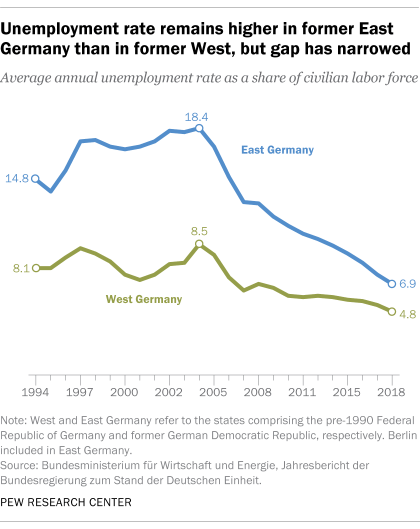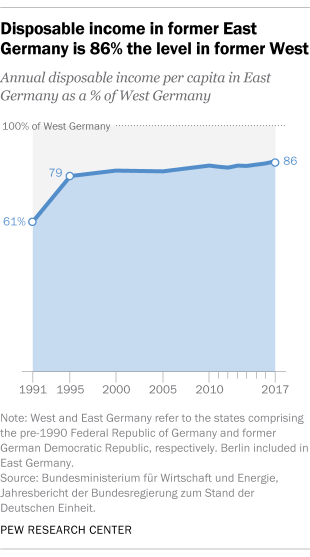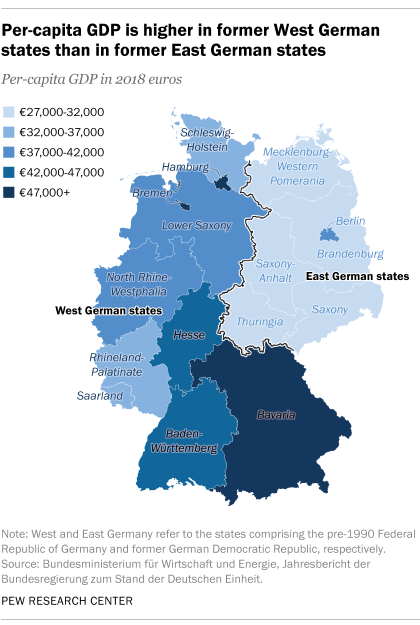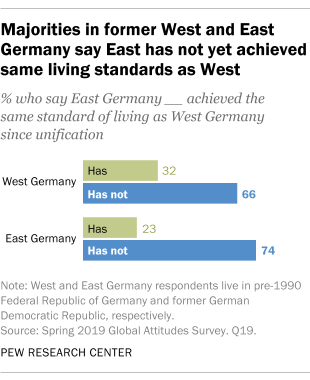
The fall of the Berlin Wall 30 years ago this week brought far-reaching social and economic changes to communist East Germany, and people on both sides of the former barrier say the changes that have occurred since 1989 have had a positive influence on living standards in their country, according to a recent Pew Research Center survey. But that does not mean the former East and West Germany are on equal economic footing today.
Despite substantial improvements in recent decades, the former East Germany continues to trail the former West Germany on important economic measures ranging from unemployment to productivity, according to an annual German government report on the “status of German unity.” (The most recent version of the report, from September, is available here in German. The 2018 version of the report is available here in English.)
See also: How the attitudes of West and East Germans compare, 30 years after fall of Berlin Wall
Here is a look at how economic conditions in the former East and West Germany have changed over time, how they compare today and how people in the two areas perceive these differences. All findings are based on data from the German government’s 2019 report, as well as the Center’s recent survey.
Unemployment is persistently higher in the former East Germany than in the former West. In 2018, the average unemployment rate was 6.9% in the six states of the former East Germany, compared with 4.8% in the 10 states of the former West Germany. (In all economic statistics in this analysis, Berlin is counted in East Germany, even though the city was divided during communism and is not directly comparable to other parts of East Germany.)

East-West differences in unemployment rates cut across demographic lines including age and gender. Among people ages 15 to 24, for example, the average unemployment rate in the former East Germany was 7.7% in 2018, compared with 4.1% in the former West. And while 7.5% of East Germans ages 55 to 64 were unemployed in 2018, the share was 5.3% among West Germans in the same age range.
Despite these differences, the former East has narrowed the gap with the former West substantially in recent decades. In the early 2000s, the unemployment rate was about 10 percentage points higher in the former East than in the former West – nearly five times the gap in 2018.

People in the former East Germany earn less than their counterparts in the former West. Total compensation, gross wages and salaries, and disposable (or after-tax) income have long been lower in the former East Germany than in the former West, according to the government’s report.
In 2017, the most recent year for which data is available, per-capita disposable income was €19,909 per year in the former East Germany – the equivalent of about $22,500 based on the average euro-to-dollar exchange rate that year. By comparison, disposable income in the former West Germany was €23,283 a year, or about $26,300.
Put another way, people in the former East Germany earned 86% the after-tax income of their West German counterparts in 2017. That percentage has changed little in recent years, but is far higher than in 1991, when per-capita disposable income in the former East was only 61% of that in the former West.
The former East Germany trails the former West in productivity. The former East has a much smaller population than the former West (about 16 million people, compared with about 67 million), but its productivity is also lower when adjusted for population differences. Per-capita gross domestic product was €32,108 in the former East German states in 2018, compared with €42,971 in the former West German states. Productivity in the East, in other words, was 75% of productivity in the West on a per-capita basis.

Five of the six states in the former East Germany – with the exception of the city-state of Berlin – had lower per-capita productivity in 2018 than the West German state with the lowest per-capita productivity, Schleswig-Holstein.
The government’s report points to several possible factors for the worse economic conditions in East Germany, including the lack of major companies headquartered there.
“Today, not a single east German company is listed on the DAX-30, the nation’s leading stock exchange index,” the report notes. “And almost no major companies have their headquarters in East Germany. Many East German businesses are part of western German or foreign corporations.”
While its per-capita productivity remains lower than that of West Germany, the former East Germany has made major gains since unification. In 1991, per-capita productivity in the former East was less than half (43%) of productivity in the former West.
Germans in both areas say living standards in the former East have not yet caught up with those in the former West.

Around three-quarters of people in the former East Germany (74%) and around two-thirds of those in the former West (66%) say the East still has not achieved the same living standards as the West, according to the Center’s recent survey, which was conducted among representative samples of adults in both areas as part of a larger study of Europe.
People in the former East Germany are also less optimistic than their counterparts in the former West on a variety of measures, including whether children today will grow up to be better off financially than their parents. In the former East, 42% of adults say the next generation will be better off, compared with 50% in the West who say this.
